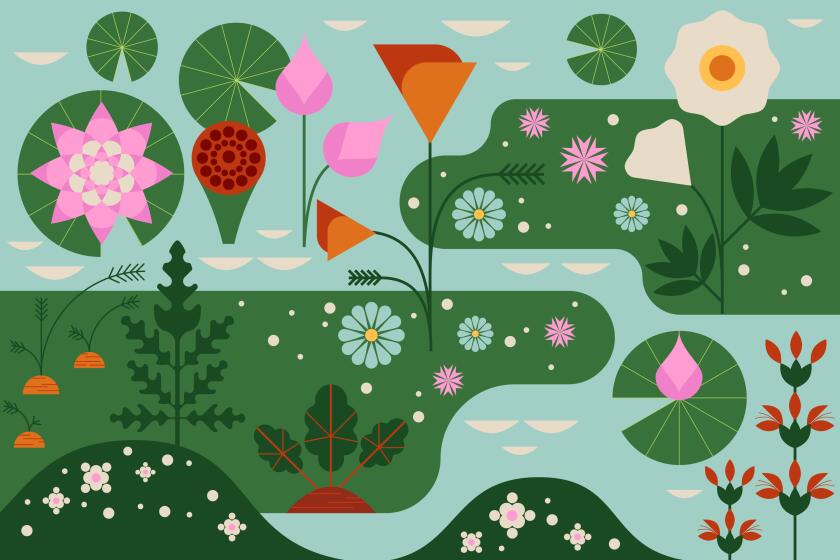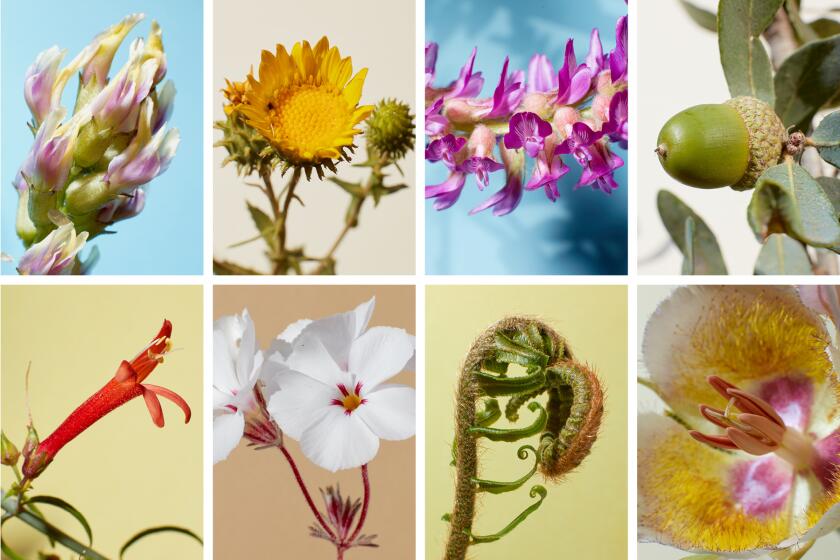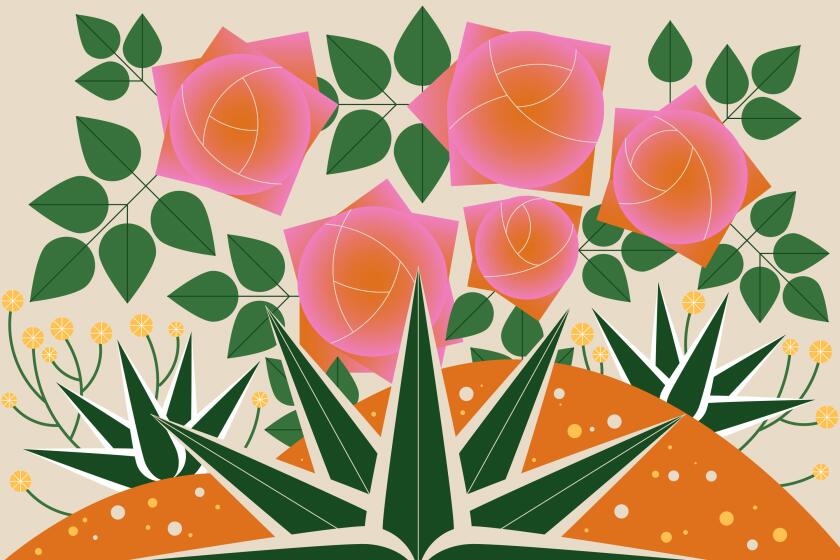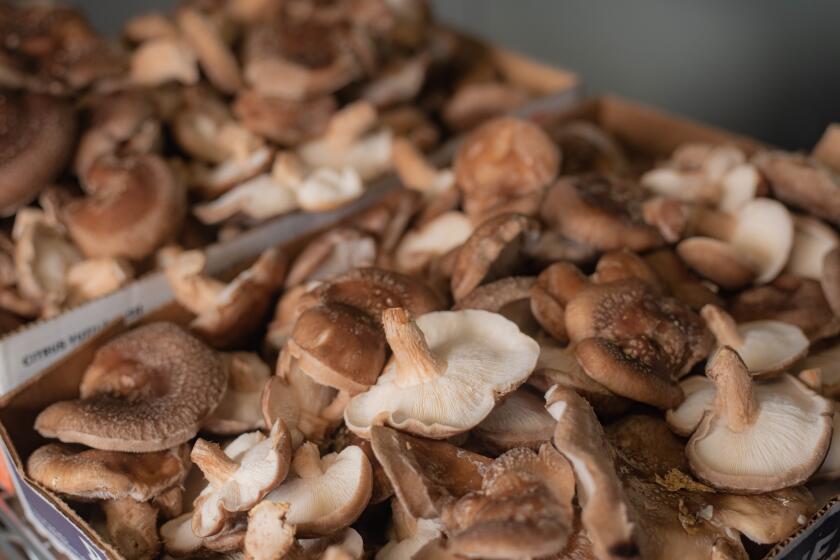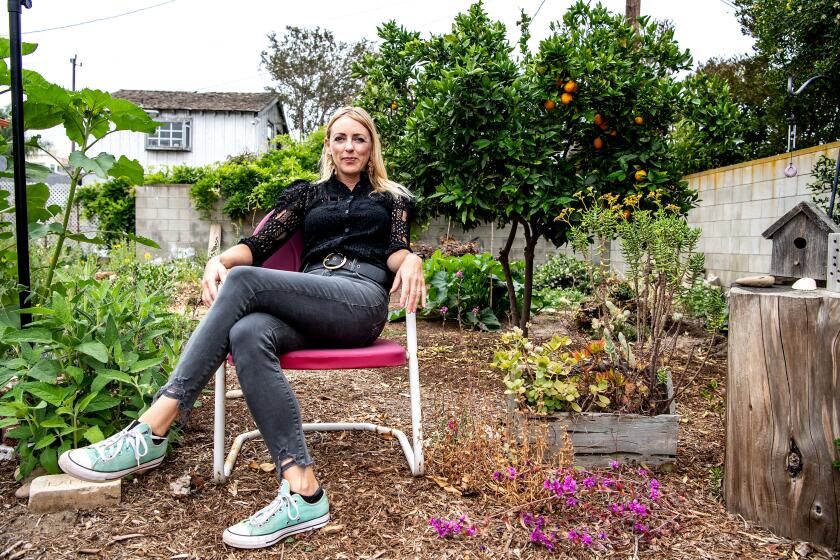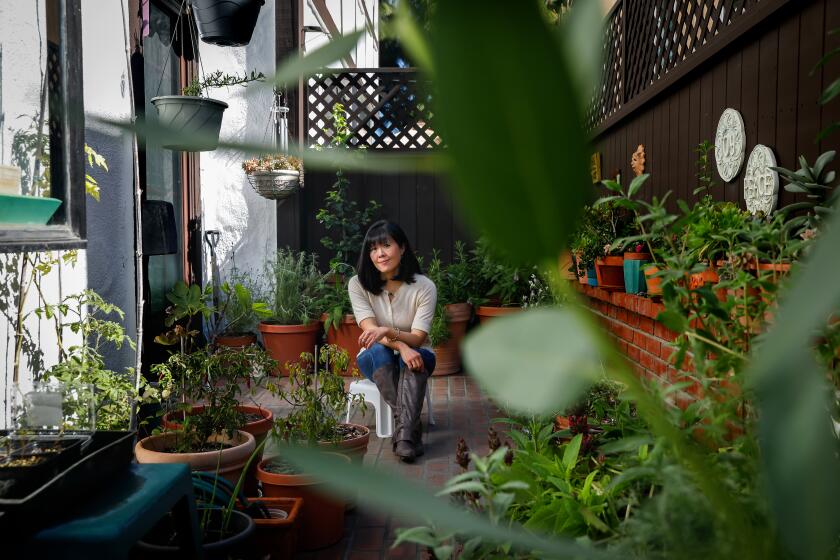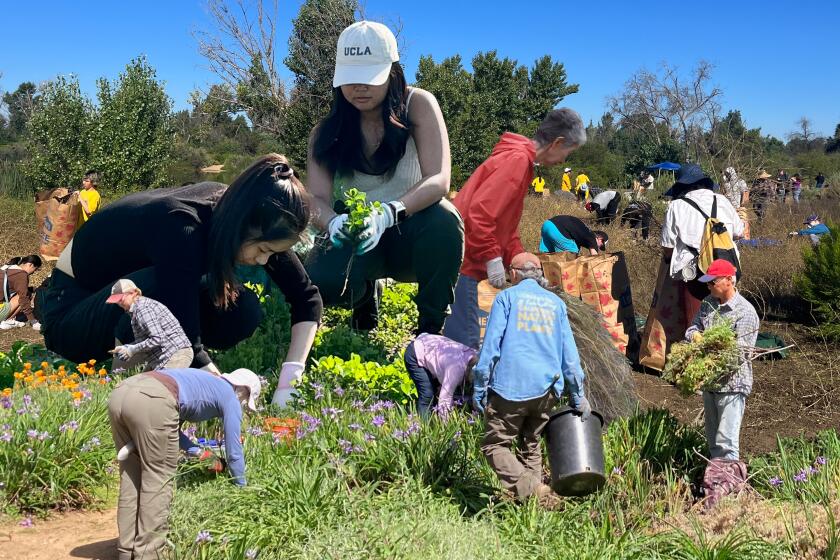6 easy ways to save rainwater and give your plants joy
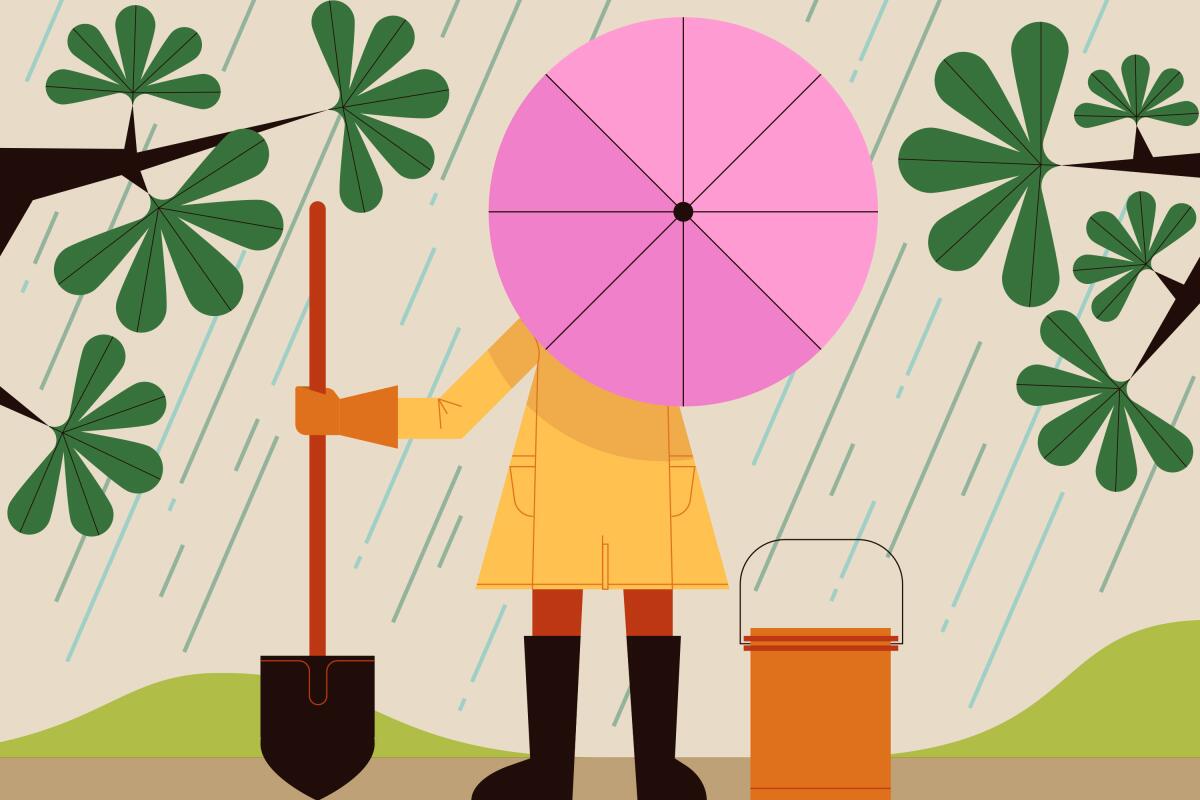
- Share via
Happy 2024! May I be the first to wish you much joy, bountiful harvests and armloads of fragrant blooms in the coming year.
You’ll find a list of plant-related events and activities below, but first, let’s address something that bugs me every time we get a good rain in Southern California — the obscene waste of all that precious water rushing off our roofs and down our streets.
You’re reading the L.A. Times Plants newsletter
Jeanette Marantos gives you a roundup of upcoming plant-related activities and events in Southern California, along with our latest plant stories.
You may occasionally receive promotional content from the Los Angeles Times.
Drought issues aside, rainwater is like a spa day for our plants, especially those in containers. They always seem perkier after a good downpour, and when times are dry, a drink of stored rainwater makes them happier than our chlorinated tap water ever could.
I have long envied people with the foresight — and funds — to bury huge cisterns in their yards, install elaborate rain gutters, and cover their patios and driveways with permeable surfaces that allow rainwater to be collected and stored for irrigation. Those big and worthy projects are a discussion for another day.
But what can we do quickly, when rain is in the forecast or happening right now, and you want to collect as much as possible? I asked a group of master gardeners and other plant experts, who gave some easy tips. These solutions aren’t particularly elegant, but they’ll get the job done.
Savvy L.A. gardeners usually start planting before April, but after weeks of rain, is it OK to plant in the mud? Expert Yvonne Savio offers tips, plus April garden events.
Before we get to the tips, however, take a minute to walk outside while it’s raining and note where the water falls most heavily from your roof — these are the best places to target for water collection. You may not even have to wait for the rain, since the areas with the heaviest flow will often cause erosion or leave other telltale signs like dirt spatters. It’s best to let the first rainfall of the season wash dirt and debris off the roof before you start collecting.
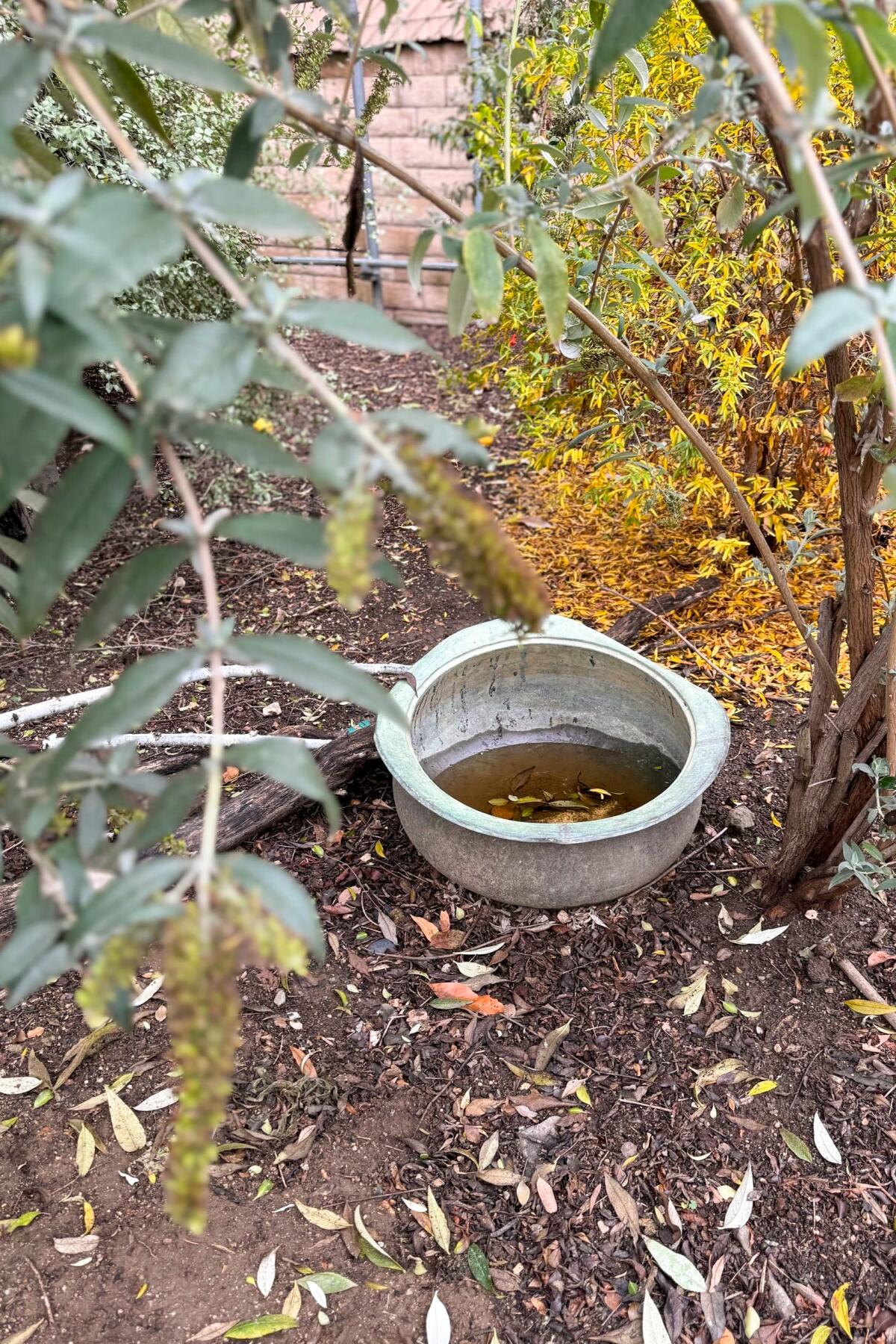
1. Grab a shovel
If your water runs off onto the ground rather than concrete or other hardscape, a very quick fix is to dig a hole under the heavy runoff places to direct as much water as possible into the ground rather than down the street, writes Ann Masterson of Shadow Hills, whose St. Francis Farm, Garden & Sanctuary grows plants for her botanical-based culinary and body products business, Treasures of Alchemy.
Water in the ground isn’t much use for irrigating pots, but your in-ground plants will love that reservoir of rainwater when things get dry.
“Creating areas to hold water in the soil is, IMO, the best option and doesn’t require purchasing anything, assuming one has access to a shovel,” Masterson writes. “I also dig holes or ‘pitchfork’ it in the garden to loosen up the soil for greater percolation. Compacted soil doesn’t have the ability to absorb water like aerated soil does.”
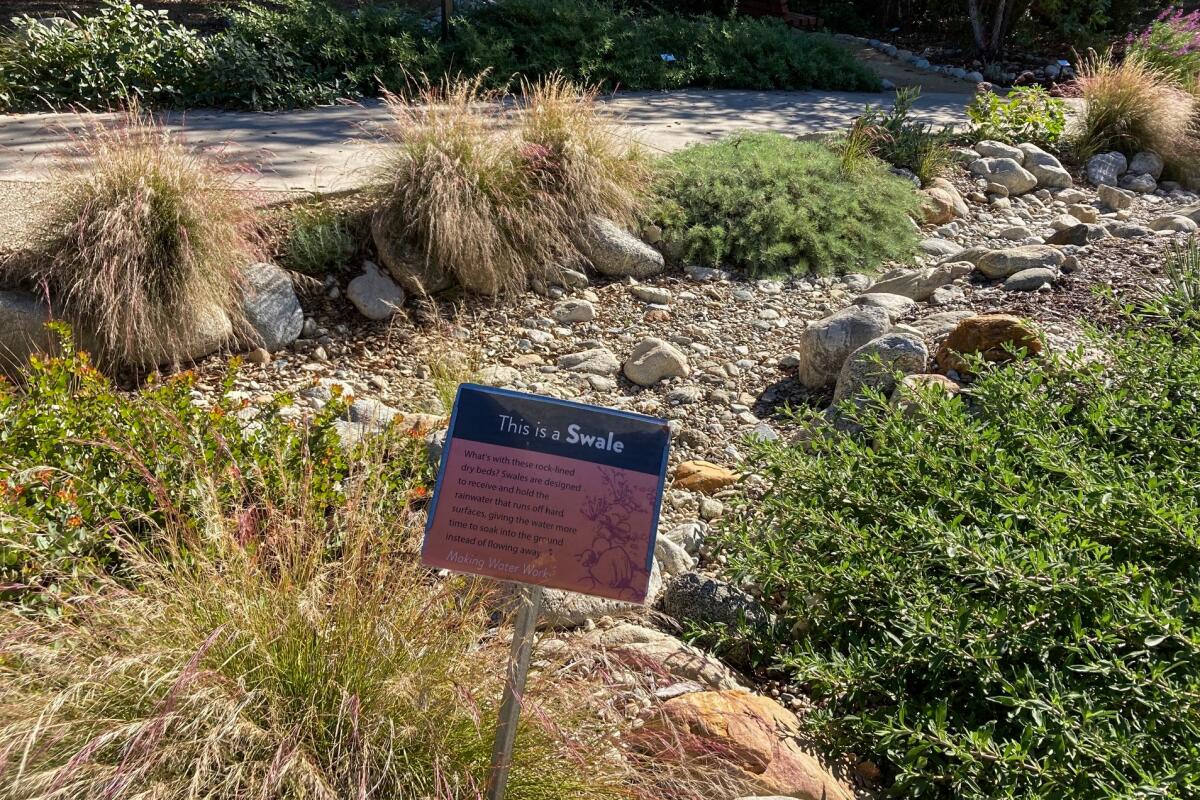
2. Dig a trench
If you have more time, try digging a trench from the runoff area to trees and other locations in your garden, says Lucinda McDade, executive director of the California Botanic Garden in Claremont, which uses several water collection techniques in its Center for Sustainable Gardening.
These trenches don’t have to be very wide, no more than a shovel width or two, 12 to 18 inches deep. If necessary, use the excavated soil to create a berm along the edges. If you have time and materials, line the bottom with the large and small stones you’d find in a dry riverbed to promote absorption by slowing the water’s flow.
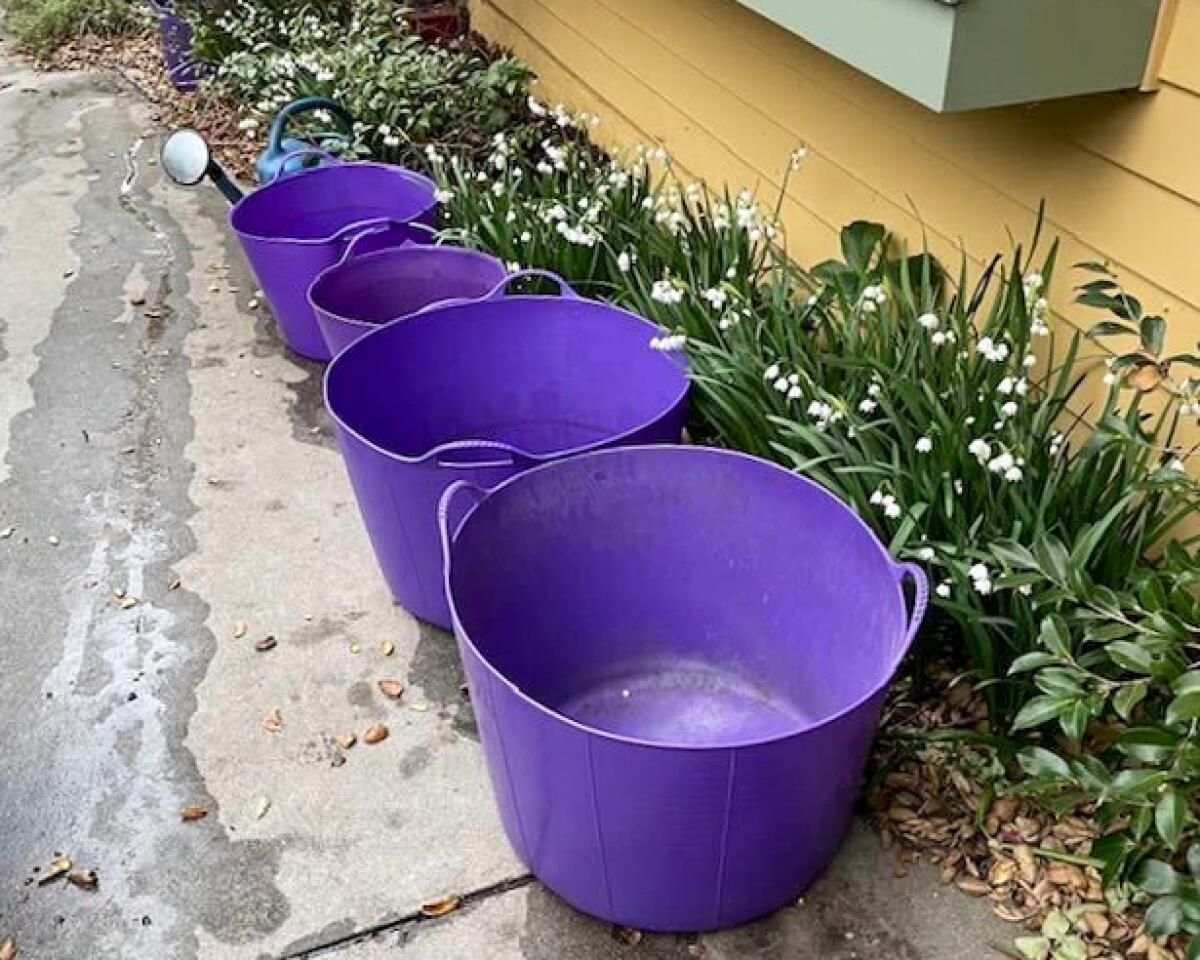
3. Gather ye containers
You can get creative here. Joan Stevens of Mamabotanica Blooms in Pasadena is a huge fan of Tubtrugs, the flexible buckets with easy-to-carry handles in various colors. “I’m pretty low-tech,” Stevens writes. “When rain is forecast, I line the area where the water falls off my shed roof (with her purple Tubtrugs) and collect a shocking amount! “
Any flexible bucket will do here but the bigger they get, the heavier they are to move once full. Master gardener Yvonne Savio, creator of the Gardening in L.A. website, has a legion of potted plants to keep watered outside her Pasadena home. She keeps her buckets on wheeled carts so she can move them around to dip water for her thirsty plants.
At 34, Matt Smith is a widower and amateur botanist whose grief and passion are fueling a quest some might call quixotic — to photograph every plant native to Los Angeles County.
When Savio runs her wall-mounted air conditioner during hot months, she uses her bucket to collect the condensed water that drains from the unit. “The bucket usually filled up within two days, she writes, and provides enough water to quench several plants. “I worked my way down the row of containers so that each pot got watered about once a week, and since I emptied the bucket every two to three days, there wasn’t sufficient time to breed any nasties.”
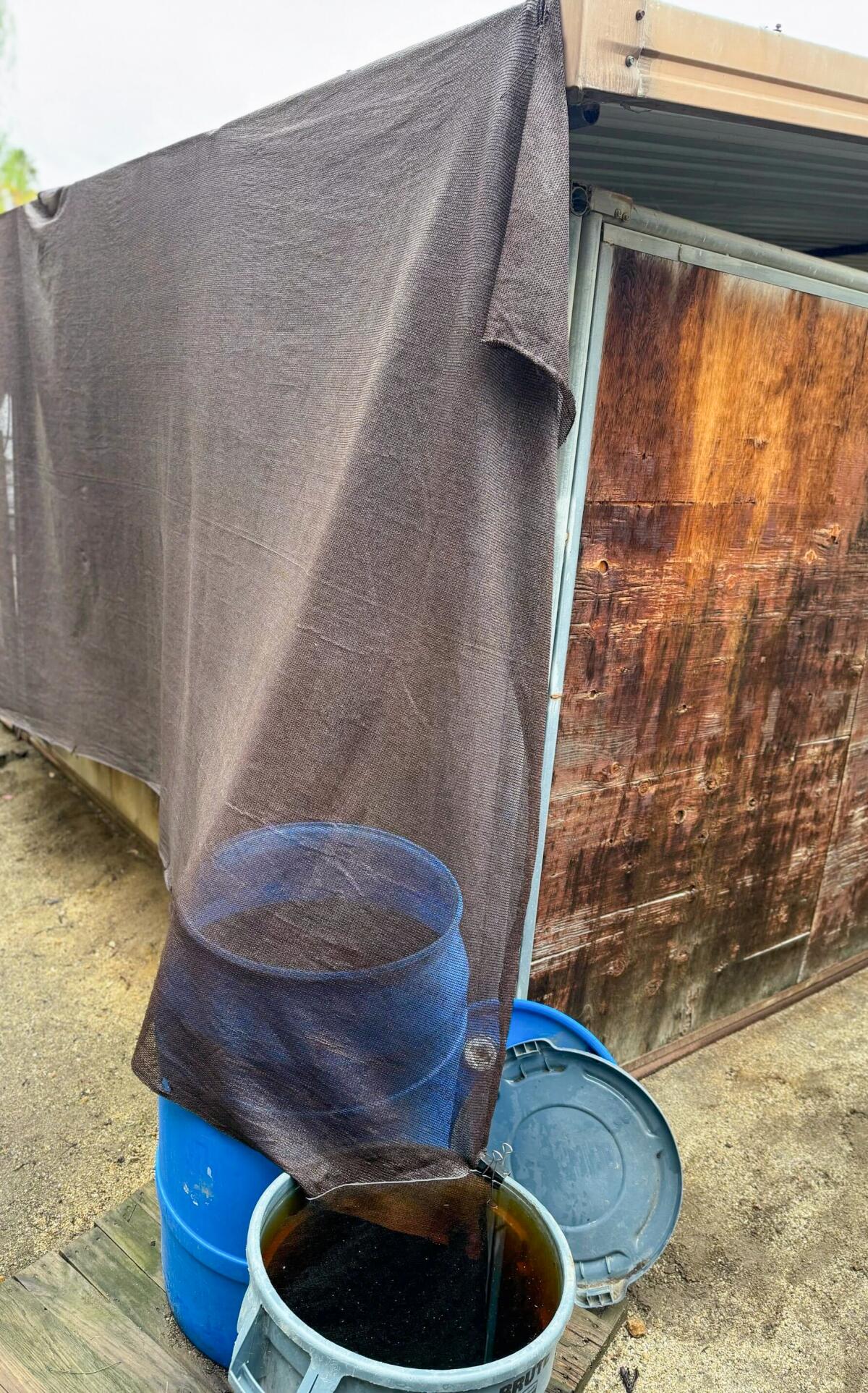
4. Take out the garbage
The least elegant but most expedient method is sticking an empty 30-gallon garbage can under the runoff. In a good rain, it will fill up quickly. You’ll need to keep it covered after that to avoid breeding “nasties” like mosquitos, but those containers can act as little wells to dip water from later in the year. However, unless you place them on a wheeled cart or dolly, they’re going to be very heavy once they’re full and not easily moved. If you don’t want them to be a permanent part of your landscape, plan for how you’ll move them once they’re full.
Non-native plants from Mediterranean climates like Australia are getting love from even wholesale California native plant growers for drought-tolerant landscapes in SoCal.
Barbara Chung, who has created a habitat garden of nearly 200 potted native plants on her tiny 7-by-20-foot patio in Santa Monica, uses a kitchen garbage can to collect rainwater that “guns” off a gully in her townhouse roof, and when it’s full she drags it against a wall a few feet away, keeping it covered until she needs the water. “I just see how much happier my plants are with rainwater,” she said. She hasn’t had any trouble with mosquitoes but her friends who live more inland use a similar technique and add mosquito dunks to the water to keep it pest-free.
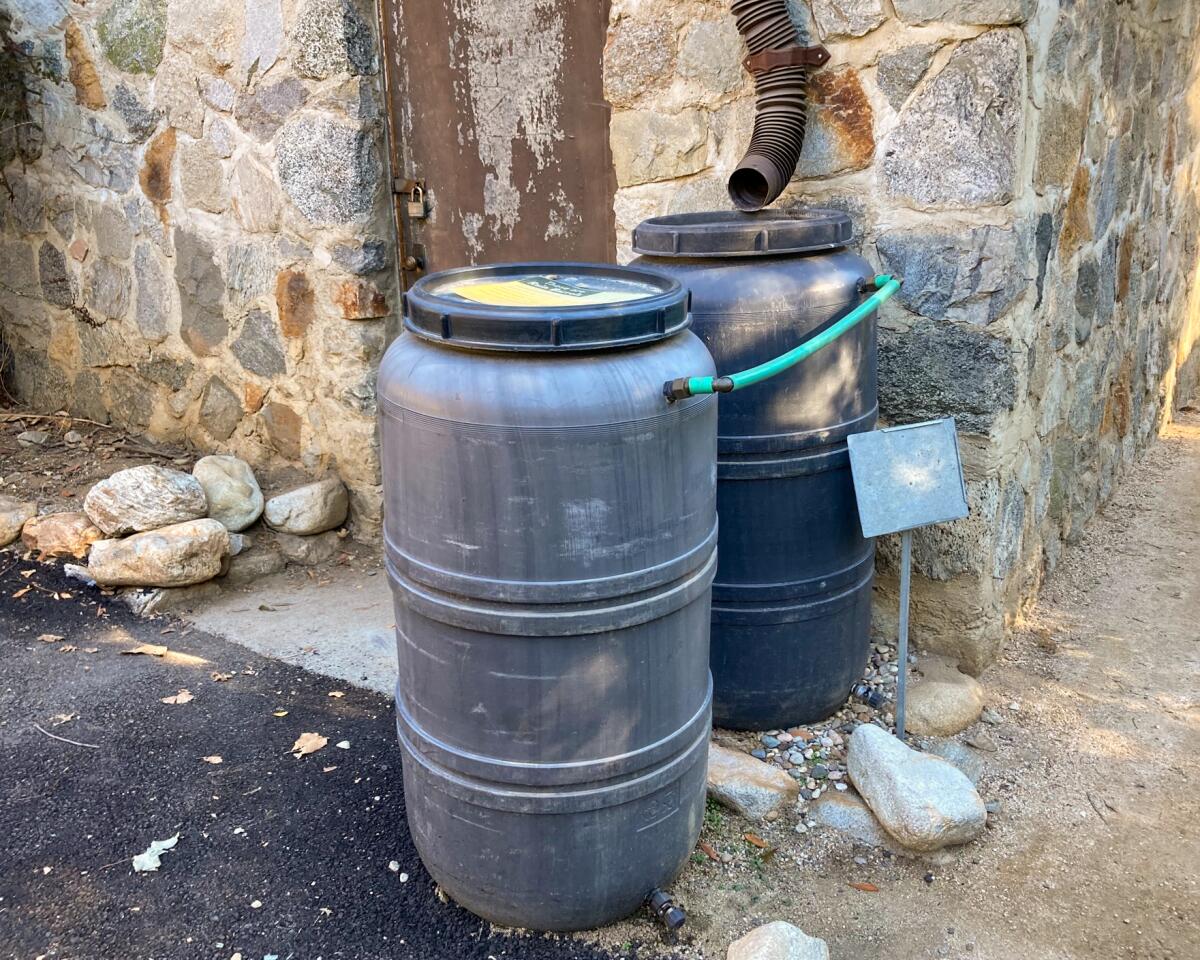
5. The thing about barrels
You can find 55-gallon rain barrels at most hardware stores for under $100. Watch for sales and check your local municipality for rebates or even giveaway programs to reduce the cost. The problem with rain barrels is that they fill up quickly, which is why some water collection experts discount their usefulness, but McDade said she solves that problem at home by linking several rain barrels together, using a simple hose to connect them so when one barrel fills the new water flows into the attached barrel. Be sure to choose rain barrels with overflow spouts at the top, so you can link them, and a spigot near the bottom to attach a hose. It’s even easier if you put the barrel on blocks or a platform so the water flows more easily.
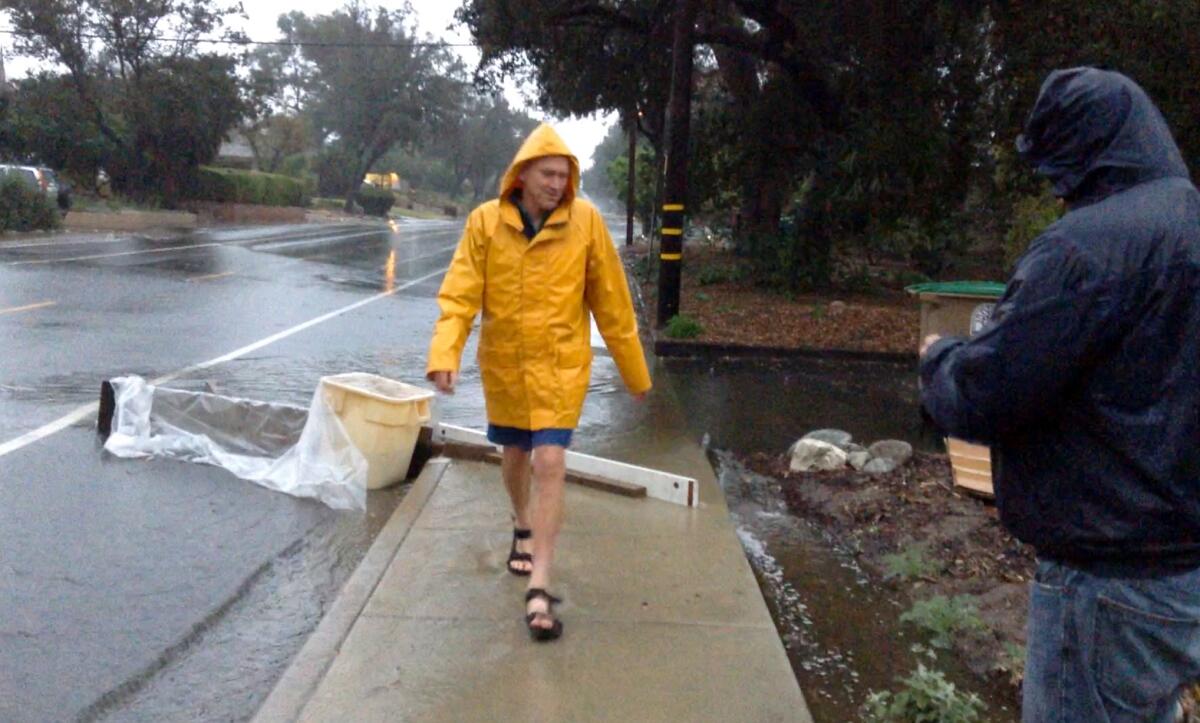
6. Guerrilla tactics
Retired arborist Mark Merritt of Claremont is fortunate enough to live at the bottom of a hill with a yard slightly lower than the sidewalk. He figures he’s diverted thousands of gallons of rainwater rushing down his street to trenches he’s dug in his yard. His technique is to create a little flood by blocking the gutter so the water flowing down the hill pools over the sidewalk and into his yard. Again, it’s not very elegant, but it works. He started by using a board in the gutter to create the diversion and now just uses sandbags.
He recommends experimenting to see what works best . “It’s kind of fun to play in the water when it’s raining.”
Cardboard is crucial for sheet mulching to kill a lawn, but critics say there’s no science proving it works. All you really need, they say, is lots of wood chips.
Upcoming events
Throughout January
The South Bay Parkland Conservancy needs volunteers for multiple restoration project work days at the Hermosa Valley Greenbelt, Esplanade Bluff Restoration, Hopkins Wilderness Park and Redondo Beach Community Garden. Advance registration required. southbayparks.org
Jan. 6, 20, 27 & 28
Palos Verdes Peninsula Land Conservancy Outdoor Volunteer Days to help restore wildlife habitat at Abalone Cove Reserve on Jan. 6, create a home for rare cactus wrens and gnatcatchers at Alta Vicente Reserve on Jan. 20 and 27 and tend the native plant demonstration garden at White Point Nature Preserve on Jan. 28. pvplc.volunteerhub.com
Jan. 6
Invasive Plant Foraging Walk, 2 to 4:30 p.m. in Elysian Park with naturalist and educator Jason “Journeyman” Wise. Learn about native and invasive plants in the park, and which invasives can be used in a tasty salad. The walk includes a take-home recipe book. Tickets $20. eventbrite.com
Growing mushrooms at home is more complicated than buying soil and seeds, but very doable with the help of premade kits. Here are expert tips on mushroom care.
Jan. 7
Finding Our Way Home With Fungi, a Theodore Payne Foundation mushroom walk and talk with Aaron Tupac of the Los Angeles Mycological Society, 11 a.m. to 1 p.m. in the Arroyo Seco in Altadena. Exact directions are provided after registration. Tickets are $35 ($25 members). eventbrite.com
Jan. 11
“The Gardener Did It! Following the Clues of Japanese-American Landscaping and Flower Growing in Southern California,” a talk by Los Angeles writer and journalist Naomi Hirahara about the significant influences Japanese-Americans have had on SoCal gardens during the January meeting of the Southern California Horticultural Society at 7:30 p.m. at Friendship Auditorium in Griffith Park. Doors open at 7 p.m., and admission is free. socalhort.org
Comprehensive Irrigation for California Native Plants, a class taught by Theodore Payne Foundation horticultural director Tim Becker from 9 a.m. to noon at the foundation’s demonstration garden in Sun Valley. Tickets are $65, ($55 members). eventbrite.com
Jan. 13 and 27
Native Plant Sales by the Palos Verdes Peninsula Land Conservancy Native Plant Sales at George F Canyon Nature Center on Jan. 13 and the White Point Nature Education Center on Jan. 27, 10:30 a.m. to noon both days. pvplc.org
Sarah Lariviere tore out her lawn and paid for a low-water replacement with a turf removal rebate. Here’s how she made it happen.
Jan. 13, 27 and Feb. 10
Drought Tolerant Landscape Design, a three-day course taught by naturalist and master gardener Laura Pasetta of Wild Rootz from 9 to 11:30 a.m. each day at the Growing Works Nursery in Camarillo. Tickets are $375. eventbrite.com
Jan. 13
Garden to Table — Carrots, a class about growing carrots taught by naturalist and master gardener Laura Pasetta of Wild Rootz from 12:30 to 2 p.m. at Growing Works Nursery in Camarillo. Tickets are $45. wild-rootz.com
Flowers for Beginners: What to Know and How to Grow, a class by Joan Stevens of Mamabotanica Blooms’ flower farm, 10 a.m. to noon in Pasadena. Tickets are $60. mamabotanica.com
Jan. 15
Palos Verdes Peninsula Land Conservancy Martin Luther King, Jr. Day of Service, 9 a.m. to noon at the White Point Nature Preserve in San Pedro. Help care for the White Point Native Plant Demonstration Garden by planting native shrubs, removing invasive weeds, watering plants and grooming trails. Free but registration is required. pvplc.volunteerhub.com
Jan. 18
California Native Plant Maintenance Basics, a walk and talk with Theodore Payne Foundation horticultural director Tim Becker from 9 to 11 a.m. in the foundation’s demonstration garden in Sun Valley. Tickets are $35 ($25 members). eventbrite.com
Jan. 25
Propagating California Native Plants From Seed, a class from 9 a.m. to noon at the Theodore Payne Foundation demonstration garden in Sun Valley. All materials are provided; students take home the seeds they’ve sown. Tickets are $85 ($75 members). eventbrite.com
Barbara Chung fell in love with native plants, but she didn’t have a yard. So she created a habitat garden in pots on her tiny townhouse patio in Santa Monica.
Jan. 26
California Native Plant Container Gardening, a class taught by Theodore Payne Foundation nursery sales associate Kyle Nguyen, 9 to 10:30 a.m. at the foundation’s garden in Sun Valley. Tickets are $25 ($20 members). eventbrite.com
Jan. 27
Fruit Tree and California Native Plants: Landscaping Together, a class taught by Joanna Glovinsky, founder of Fruitinstitute, from 11 a.m. to 12:30 p.m. at the Theodore Payne Foundation in Sun Valley, Tickets are $35 ($30 members). eventbrite.com
Sunset Queer Ecology Walk led by Jason “Journeyman” Wise, 4 to 6:30 p.m. in Griffith Park. The walk is a two-mile exploration of local ecosystems through the lens of queer ecology. Tickets are $10. eventbrite.com
One of the best ways to learn more about plants is to volunteer at Los Angeles area nurseries, botanic gardens, nature groups and plant advocacy organizations.
What we’re reading
After Angeleno Matt Smith lost his wife to cancer, he took his grief and turned it into a quest to photograph every native plant in L.A. County.
Drought tolerance isn’t a reason to landscape with non-native plants, writes Charles Miller, chair of the Los Angeles chapter of the Climate Reality Project and its Biodiversity Committee. We must landscape our public spaces and private yards with native plants to support California’s imperiled insects, songbirds and other species. “The idea that human beings know better than millions of years of evolution is the height of hubris,” Miller writes in his op-ed, “Here’s what’s wrong with your perfectly drought-tolerant Southern California landscaping.” “Next spring, when you see the lovely purple flowers on the nonnative jacaranda trees planted all over L.A., stop to notice that not a single butterfly is pollinating them”
News about the wars abroad and a family emergency here at home left my colleague Deborah Vankin sleepless and drained. Then someone invited her to try Forest Therapy. “ I was skeptical, but game,” she wrote. “Seeking refuge in nature is hardly new and need not be exclusive — but why pay for it? And how was this therapy?”
Consider subscribing to the Los Angeles Times
Your support helps us deliver the news that matters most. Become a subscriber.
Coast redwoods are the tallest plants on the planet; ecosystems that support a broad range of other life forms. They live for hundreds of years, but can they adapt fast enough to climate change to survive?
No, succulents aren’t great air purifiers, but who knew they were popular behind the Iron Curtain? Learn more in this interview with Jared D. Margulies, author of “The Cactus Hunters: Desire and Extinction in the Illicit Succulent Trade.”
Something I missed from November — the U.S. Department of Agriculture has revised its Plant Hardiness Zone Map, for the first time in a decade, to reflect warming temperatures due to climate change. The map lays out growing regions based on an average of the lowest winter temperatures for the past 30 years, and across the lower 48 states, “the lowest likely winter temperature overall is 2.5 degrees warmer” than when the map was last published in 2012.
Sign up for The Wild
We’ll help you find the best places to hike, bike and run, as well as the perfect silent spots for meditation and yoga.
You may occasionally receive promotional content from the Los Angeles Times.
